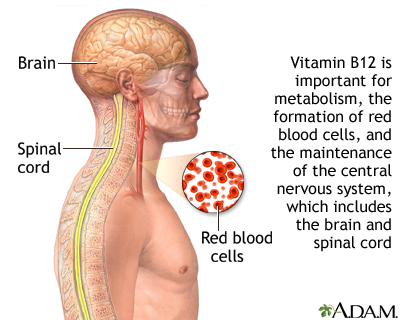Vitamin B12 level
Cobalamin test; Pernicious anemia - vitamin B12 level
The vitamin B12 level is a blood test that measures how much vitamin B12 is in your blood.
Images


How the Test is Performed
A blood sample is needed.
How to Prepare for the Test
You should not eat or drink for about 6 to 8 hours before the test.
Certain medicines may affect the results of this test. Your health care provider will tell you if you need to stop taking any medicines. Do not stop any medicine before talking to your provider.
Medicines that can affect the test result include:
- Colchicine
- Neomycin
- Para-aminosalicylic acid
- Phenytoin
How the Test will Feel
When the needle is inserted to draw blood, some people feel moderate pain. Others feel only a prick or stinging. Afterward, there may be some throbbing or a slight bruise. This soon goes away.
Why the Test is Performed
This test is most often done when other blood tests suggest a condition called megaloblastic anemia. Pernicious anemia causes a form of megaloblastic anemia caused by vitamin B12 deficiency due to poor vitamin B12 absorption. This can occur when the stomach makes less of the substance (called intrinsic factor) the body needs to efficiently absorb vitamin B12.
Your provider may also recommend a vitamin B12 test if you have certain nervous system symptoms. A low level of B12 can cause numbness or tingling in the arms and legs, weakness, and loss of balance.
Other conditions for which the test may be done include:
- Sudden severe confusion (delirium)
- Loss of brain function (dementia)
- Dementia due to metabolic causes
- Nerve abnormalities, such as peripheral neuropathy
Normal Results
Normal values are 160 to 950 picograms per milliliter (pg/mL), or 118 to 701 picomoles per liter (pmol/L).
Normal value ranges may vary slightly among different laboratories. Some labs use different measurements or may test different samples. Talk to your provider about what your specific test results mean.
What Abnormal Results Mean
Values of less than 160 pg/mL (118 pmol/L) are a possible sign of a vitamin B12 deficiency. People with this degree of deficiency are likely to have or develop symptoms.
Deficiency should be confirmed by checking the level of a substance in the blood called methylmalonic acid. A high level indicates a true B12 deficiency.
Causes of vitamin B12 deficiency include:
- Not enough vitamin B12 in diet (rare, except with a strict vegetarian diet)
- Diseases that cause malabsorption (for example, celiac disease and Crohn disease)
- Lack of intrinsic factor, a protein that helps the intestine absorb vitamin B12 efficiently
- Above normal body heat production (for example, with hyperthyroidism)
- Pregnancy
An increased vitamin B12 level is uncommon. Usually, excess vitamin B12 is removed in the urine.
Conditions that can increase B12 level include:
- Liver disease (such as cirrhosis or hepatitis)
- Myeloproliferative disorders (for example, polycythemia vera and chronic myelogenous leukemia)
Risks
There is little risk involved with having your blood taken. Veins and arteries vary in size from one person to another and from one side of the body to the other. Taking blood from some people may be more difficult than from others.
Other risks associated with having blood drawn are slight, but may include:
- Excessive bleeding
- Fainting or feeling lightheaded
- Multiple punctures to locate veins
- Hematoma (blood buildup under the skin)
- Infection (a slight risk any time the skin is broken)
Related Information
Vitamin B12CBC blood test
Reticulocyte count
Pernicious anemia
Malabsorption
Celiac disease – sprue
Hyperthyroidism
Cirrhosis
Hepatitis
Polycythemia vera
Chronic myelogenous leukemia (CML)
Delirium
Dementia
Dementia due to metabolic causes
References
Marcogliese AN, Hensch L. Resources for the hematologist: interpretive comments and selected reference values for neonatal, pediatric, and adult populations. In: Hoffman R, Benz EJ, Silberstein LE, et al, eds. Hematology: Basic Principles and Practice. 8th ed. Philadelphia, PA: Elsevier; 2023:chap 159.
Mason JB, Booth SL. Vitamins, trace minerals, and other micronutrients. In: Goldman L, Cooney KA, eds. Goldman-Cecil Medicine. 27th ed. Philadelphia, PA: Elsevier; 2024:chap 199.
Stabler SP. Megaloblastic anemias. In: Goldman L, Cooney KA, eds. Goldman-Cecil Medicine. 27th ed. Philadelphia, PA: Elsevier; 2024:chap 150.
BACK TO TOPReview Date: 3/31/2024
Reviewed By: Todd Gersten, MD, Hematology/Oncology, Florida Cancer Specialists & Research Institute, Wellington, FL. Review provided by VeriMed Healthcare Network. Also reviewed by David C. Dugdale, MD, Medical Director, Brenda Conaway, Editorial Director, and the A.D.A.M. Editorial team. Editorial update 08/19/2024.

Health Content Provider
06/01/2025
|
A.D.A.M., Inc. is accredited by URAC, for Health Content Provider (www.urac.org). URAC's accreditation program is an independent audit to verify that A.D.A.M. follows rigorous standards of quality and accountability. A.D.A.M. is among the first to achieve this important distinction for online health information and services. Learn more about A.D.A.M.'s editorial policy, editorial process and privacy policy. A.D.A.M. is also a founding member of Hi-Ethics. This site complied with the HONcode standard for trustworthy health information from 1995 to 2022, after which HON (Health On the Net, a not-for-profit organization that promoted transparent and reliable health information online) was discontinued. |
The information provided herein should not be used during any medical emergency or for the diagnosis or treatment of any medical condition. A licensed medical professional should be consulted for diagnosis and treatment of any and all medical conditions. Links to other sites are provided for information only -- they do not constitute endorsements of those other sites. © 1997- 2025 A.D.A.M., a business unit of Ebix, Inc. Any duplication or distribution of the information contained herein is strictly prohibited.
